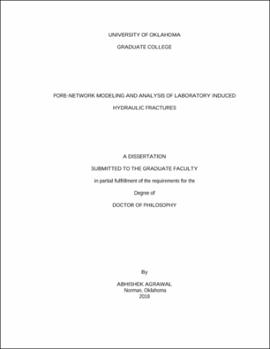| dc.contributor.advisor | Devegowda, Deepak | |
| dc.contributor.advisor | Sakhaee-Pour, Ahmad | |
| dc.contributor.author | Agrawal, Abhishek | |
| dc.date.accessioned | 2018-05-22T18:18:07Z | |
| dc.date.available | 2018-05-22T18:18:07Z | |
| dc.date.issued | 2018-05 | |
| dc.identifier.uri | https://hdl.handle.net/11244/299949 | |
| dc.description.abstract | Well stimulation is undertaken to reduce the restriction to flow in a reservoir. Among all the well stimulation techniques, hydraulic fracturing is one of the most widely employed techniques due to the development of shale and tight sand resources. The present study focuses on two problems relevant to hydraulic fracturing; predicting the transport properties enhancement as a function of recorded acoustic emission (AE) events during hydraulic fracturing and predicting the breakdown pressures in cyclic fracturing.
To study the first problem, I initiate pore-scale modeling of acoustic emission (AE) events based on percolation theory. The primary objective is to predict the permeability enhancement by accounting for the number of AE events. I first develop a physically representative model of the intact pore space of the matrix of Tennessee sandstone at the core scale based on petrophysical measurements, which are porosity, permeability, and capillary pressure. A block-scale sample of the formation is then hydraulically fractured, where piezoelectric sensors record the events generated during stimulation. I predict the permeability enhancement of the formation at the core scale by accounting for the number of AE events per unit volume. Independent petrophysical measurements corroborate the predicted results based on percolation theory. The proposed model has significant implications for characterizing the transport properties of the stimulated reservoir volume.
The second problem is relevant to predicting the breakdown pressure in hydraulic fracturing. In conventional fracturing, the fluid pressure is increased monotonically to reach failure in a single cycle. The breakdown pressure can be reduced if we increase and decrease the fluid pressure cyclically (cyclic fracturing). This phenomenon has been tested in other fields, but it is not yet possible to predict the breakdown pressure and cycle in petroleum engineering in the context of hydraulic fracturing. The present study proposes a workflow based on a modified Paris law to predict the breakdown pressure and cycle of cyclic fracturing. The modified Paris law is based on linear elastic fracture mechanics (LEFM), which treats the solid domain as an isotropic and linear elastic medium. I use the data available in the literature for dry Tennessee sandstones. The samples were hydraulically fractured under triaxial stress, two with conventional and two with cyclic methods. The results show that the tuned Paris law can predict the breakdown pressure and cycle with reasonable accuracy. The tuned model can help us to design an optimum scenario that is fundamentally different from the conventional method for formation stimulation. | en_US |
| dc.language | en_US | en_US |
| dc.subject | Acoustic Emission (AE) | en_US |
| dc.subject | Percolation Theory | en_US |
| dc.subject | Hydraulic Fracturing | en_US |
| dc.subject | Cyclic Fracturing | en_US |
| dc.subject | Paris Law | en_US |
| dc.title | PORE-NETWORK MODELING AND ANALYSIS OF LABORATORY INDUCED HYDRAULIC FRACTURES | en_US |
| dc.contributor.committeeMember | Pranter, Matthew | |
| dc.contributor.committeeMember | Fahes, Mashhad | |
| dc.contributor.committeeMember | Reza, Zulfiquar | |
| dc.contributor.committeeMember | Salehi, Saeed | |
| dc.date.manuscript | 2018-05 | |
| dc.thesis.degree | Ph.D. | en_US |
| ou.group | Mewbourne College of Earth and Energy::Mewbourne School of Petroleum and Geological Engineering | en_US |
